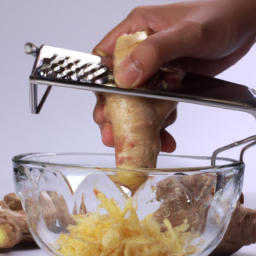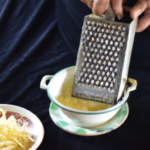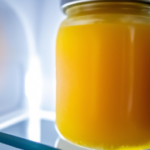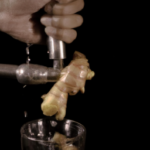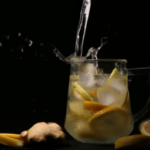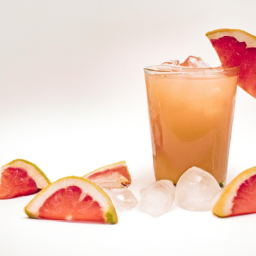I absolutely love ginger! It adds a unique flavor and aroma to dishes and drinks, and it comes with many health benefits. However, not everyone has a juicer or blender to make ginger juice. **But don’t worry, I have a solution to share!**
Fortunately, there are several easy and practical ways to juice ginger without any special equipment. In this article, I will share four methods for juicing ginger, as well as tips for getting the most juice and storing fresh ginger. Plus, I’ll give you some delicious recipes to try using ginger juice and explain why ginger is so good for you.
Ginger is a root that has been used for centuries for medicinal and culinary purposes. It contains compounds called gingerols and shogaols, which have anti-inflammatory and antioxidant properties, among other health benefits. Some of the benefits of consuming ginger include reducing nausea, improving digestion, and promoting heart health.
Whether you want to add ginger to your meals or drinks for its flavor or its health benefits, juicing ginger is a great way to get more of this amazing root into your diet. So, let’s get started on learning how to juice ginger without a juicer or blender!
Key Takeaways
- Grating and squeezing ginger or using a garlic press are easy ways to juice ginger without special equipment.
- Ginger can also be juiced with bare hands and a ginger root, using a mortar and pestle, or by boiling and straining.
- Choose smooth and firm ginger, peel it with a vegetable peeler or spoon, and store it correctly to preserve freshness.
- Ginger is a versatile ingredient that can be added to smoothies, teas, stir-fries, baked goods, oatmeal, and yogurt to enjoy its health benefits.
Why Ginger is a Great Addition to Your Diet
You’re missing out on all the amazing health benefits of ginger if you’re not adding it to your diet regularly! Ginger is a root that has been used for centuries in traditional medicine due to its anti-inflammatory and antioxidant properties. Consuming ginger has been linked to improved digestion, reduced nausea, and lower levels of inflammation in the body.
There are many ways to incorporate ginger into your daily diet. You can add freshly grated ginger to your smoothies, stir-fries, or even steep it in hot water for a refreshing ginger tea. You can also add dried ginger to your baked goods or sprinkle it on top of your oatmeal or yogurt in the morning.
With so many delicious and easy ways to add ginger to your meals, there’s no reason not to start reaping the benefits of this powerful root today! And the best part? You don’t even need a juicer or blender to get started!
Method 1: Grating and Squeezing Ginger
First, grab a grater and a piece of ginger to start extracting its flavorful goodness without any fancy equipment. Here are three things to consider when using the grating technique for juicing ginger:
-
Choose fresh ginger with a smooth, unblemished surface and a firm texture. You can find ginger in most grocery stores, and it’s usually sold by the pound or by the piece. For juicing, a small piece of ginger, about the size of your thumb, should be enough.
-
Peel the ginger using a vegetable peeler or a spoon to scrape off the skin. Then, use the fine side of the grater to shred the ginger into a bowl. Be careful not to grate your fingers in the process!
-
Squeeze out the juice from the grated ginger using a cheesecloth or a clean kitchen towel. Gather the corners of the cloth and twist it tightly to extract as much juice as possible.
The resulting ginger juice can be used in many ways, including adding it to smoothies, marinades, dressings, or teas.
Now that you’ve learned the grating technique, let’s move on to the next method of juicing ginger using a garlic press.
Method 2: Using a Garlic Press
For this method of juicing ginger without a juicer or blender, all you need is a garlic press and fresh ginger root.
First, peel the ginger and cut it into small pieces that can fit into the garlic press.
Then, place the ginger pieces into the garlic press and squeeze the juice out, collecting it in a bowl or cup.
This method is quick, easy, and efficient for juicing small amounts of ginger.
Tools Needed
Tools needed:
All you need are two bare hands and a ginger root the size of a small watermelon to juice ginger without a juicer or blender. It’s one of the simplest alternative methods to make ginger juice, but the trick is to have the right tools.
First, make sure you have a good quality ginger root that’s firm, smooth, and wrinkle-free. Then, hold the ginger root in one hand and use the other hand to press and twist it firmly against your palm. Repeat this process until all the juice is extracted from the ginger.
Once you’ve extracted all the juice, you may want to filter it through a fine mesh strainer or cheesecloth to remove any pulp or fiber. This will give you a smooth, clear juice that’s easy to drink or use in your recipes.
Now that you know the tools needed, let’s move on to the step-by-step instructions for juicing ginger without a juicer or blender. First, start by thoroughly washing and peeling the ginger root to remove any dirt or impurities. Next, use a fine grater or a microplane to grate the ginger into small pieces, which will release its juices more easily. This method of juicing ginger without a juicer can be highly effective, as you can then squeeze the grated ginger through a cheesecloth or fine sieve to extract the liquid.
Step-by-Step Instructions
Are you ready to learn a simple and effective way to extract the healthy benefits of ginger right at home? Look no further than these alternative methods for juicing ginger without a juicer or blender.
-
Wash and peel the ginger root: Make sure to wash the ginger root thoroughly before peeling it. Use a vegetable peeler or a knife to remove the skin.
-
Grate the ginger: Using a fine grater, grate the peeled ginger root into a bowl.
-
Squeeze the ginger: Take a handful of the grated ginger and squeeze it over a separate bowl to extract the juice. Repeat until all of the grated ginger has been juiced.
-
Strain the juice: Use a fine mesh strainer to remove any remaining pulp from the ginger juice.
By following these simple steps, you can easily extract the juice from ginger and enjoy the many benefits of ginger juice, such as its anti-inflammatory properties and ability to aid digestion.
Now, let’s move on to the next method of juicing ginger without a juicer or blender.
Method 3: Using a Mortar and Pestle
Feeling frustrated with the lack of juicing equipment? No problem, grab a mortar and pestle and get ready to pound some ginger into juice! This method is perfect for those who don’t have a juicer or blender and want to extract the juice from ginger quickly and easily. When using a mortar and pestle, it’s important to choose the right ginger variety and to be aware of mortar and pestle alternatives.
To begin, select a ginger root that is fresh and firm. The best ginger varieties for juicing are young and tender, with a thin skin that is easy to peel. Once you’ve chosen your ginger, remove the skin using a vegetable peeler or knife. Cut the ginger into small pieces and place them inside the mortar. Use the pestle to crush the ginger pieces into a pulp. Add a small amount of water to the mixture and continue to grind until the ginger juice is extracted. Finally, strain the juice through a fine-mesh sieve or cheesecloth to remove any remaining pulp or fibers.
Now that you’ve learned how to juice ginger using a mortar and pestle, let’s move on to the next method. Method 4 involves boiling and straining ginger, which is another easy way to extract the juice from ginger without any special equipment.
Method 4: Boiling and Straining Ginger
Now, if you’re looking for a quick and easy way to extract ginger juice without the use of any kitchen equipment, then boiling and straining ginger might just be the perfect method for you.
Boiling ginger is an excellent way to soften it up and make it easier to extract the juice. The process is quite simple. All you need to do is peel the ginger and chop it into small pieces before boiling it in water for about 10-15 minutes. Once the ginger has boiled, you can strain it and collect the juice in a container.
Straining ginger juice is a crucial step in this process as it removes all the fibrous bits and chunks that may have been left behind during the boiling process. This method is not only easy but also an effective way to extract ginger juice. Plus, it’s a great way to enjoy a warm cup of ginger tea.
Now that you know how to extract ginger juice using boiling and straining methods, let’s move on to some tips for getting the most juice from your ginger.
Tips for Getting the Most Juice from Your Ginger
To maximize the amount of ginger extract you get, try grating the ginger before squeezing it through a cheesecloth or fine mesh strainer. Here are some juicing hacks to help you get the most juice from your ginger:
- Use a microplane or fine grater to shred the ginger into tiny pieces.
- Place the grated ginger in a cheesecloth or fine mesh strainer.
- Squeeze the ginger to extract the juice.
If using a cheesecloth, twist and squeeze the cloth to get every last drop of juice. Use a spoon to press down on the ginger in the strainer to extract more juice.
These tips will ensure that you get the most juice possible from your ginger, without the need for a juicer or blender. But, what do you do with all that extra ginger? In the next section, we’ll discuss ginger preservation and how to store fresh ginger for future use.
How to Store Fresh Ginger
Did you know that storing fresh ginger properly can extend its shelf life by several weeks or even months? It’s important to store ginger correctly to preserve its freshness and flavor. When ginger is stored in the right way, it can be used in many different recipes, including those that require ginger juice.
To store fresh ginger, start by selecting a piece of ginger that is firm, plump, and free from wrinkles. Then, wrap the ginger in a paper towel and place it in a resealable plastic bag. Store the bag in the crisper drawer of your refrigerator, where the temperature is cooler and more consistent. Properly stored ginger can last up to three weeks in the refrigerator, while frozen ginger can last up to six months. To freeze ginger, peel it and chop it into small pieces, then place it in an airtight container or freezer bag.
For even more tips on storing ginger, check out the table below:
| Method | Shelf Life |
|---|---|
| Refrigerator (wrapped in paper towel and stored in a resealable plastic bag) | Up to 3 weeks |
| Freezer (peeled, chopped, and stored in an airtight container or freezer bag) | Up to 6 months |
| Preserved ginger (stored in a jar with sugar syrup) | Up to 1 year |
| Pickled ginger (stored in a jar with vinegar) | Up to 6 months |
| Dried ginger (stored in an airtight container) | Up to 2 years |
Now that you know how to store fresh ginger, you can easily preserve ginger juice for use in various recipes. In the next section, we’ll explore some delicious recipes that incorporate ginger juice.
Recipes for Using Ginger Juice
I love using ginger juice in my cooking and beverages because of its unique flavor and health benefits. Three of my favorite recipes featuring ginger juice are ginger lemonade, ginger tea, and ginger salad dressing.
Ginger lemonade is a refreshing and zesty drink that’s perfect for hot summer days. Ginger tea is a soothing and warming beverage that can help with digestion and inflammation. Lastly, ginger salad dressing is a simple and flavorful way to add a kick to your favorite greens.
Ginger Lemonade
Get ready to quench your thirst with a refreshing ginger lemonade that’s easy to make without a juicer or blender! This recipe is perfect for those hot summer days when you need something cool and refreshing.
To make ginger lemonade, you’ll need fresh ginger, lemons, water, and sugar. You can adjust the sweetness to your liking by adding more or less sugar. One of the great things about ginger lemonade is that you can customize it to your taste.
There are many variations of this drink, from adding mint or basil for a herbal twist, to making it a ginger-infused cocktail by adding some vodka or gin. Whatever your preference, ginger lemonade is a delicious way to enjoy the benefits of ginger, which is known for its anti-inflammatory and digestive properties.
So why not give it a try and see how you like it? Now, let’s move on to another popular way to consume ginger – ginger tea.
Ginger Tea
Savor the warmth and comfort of a steaming cup of ginger tea, brewed with fresh ginger root and aromatic spices that’ll transport you to a cozy winter evening. Here are some ways to make ginger tea without a juicer or blender:
- Grate fresh ginger root into a pot of boiling water and let it simmer for 10-15 minutes. Strain and add honey or lemon to taste.
- Use ginger tea bags, which can be found in most grocery stores. Steep for 5-10 minutes in hot water and add your choice of sweetener.
- Mix grated ginger, cinnamon, black pepper, and turmeric in a tea infuser or cheesecloth and steep in hot water for 10-15 minutes. Strain and add honey or milk for a creamy texture.
- Try a ginger and green tea combo by steeping a green tea bag and sliced ginger in hot water for 5 minutes. Add honey or lemon to taste.
Ginger tea alternatives include adding fresh mint leaves, sliced lemon or orange, and even a sprinkle of cayenne pepper for an added kick. Not only does ginger tea provide a cozy and comforting sensation, but it also has numerous health benefits such as aiding digestion, reducing inflammation, and boosting immunity.
As we move on to the next section about ginger salad dressing, remember that incorporating ginger into your diet in various ways can provide a range of benefits for your overall health and well-being.
Ginger Salad Dressing
Indulge in the rich flavors of a ginger-infused salad dressing, made with a combination of tangy vinegar, aromatic sesame oil, and a touch of sweetness from honey or agave nectar.
This ginger marinade is perfect for adding a zing to your greens and vegetables. Simply whisk together all the ingredients, and drizzle it over your salad for a burst of flavor that will tantalize your taste buds.
If you prefer a thicker consistency, you can blend the ingredients in a food processor or blender until smooth.
This ginger vinaigrette also pairs well with chicken or fish, making it a versatile addition to your kitchen. Not only does it add a kick of flavor to your dishes, but ginger is also known for its many health benefits.
From reducing inflammation to aiding digestion, adding ginger to your meals can be a simple and delicious way to boost your overall health.
Health Benefits of Ginger
You wouldn’t believe the amazing health benefits of ginger, from reducing inflammation to aiding digestion. Here are some of the reasons why you should consider adding ginger to your diet:
-
Ginger can help reduce nausea and vomiting, making it a great natural remedy for morning sickness, motion sickness, and chemotherapy-induced nausea.
-
Ginger has anti-inflammatory properties that can help reduce pain and inflammation in the body, making it a great natural remedy for conditions like osteoarthritis and rheumatoid arthritis.
-
Ginger may help lower blood sugar levels and improve insulin sensitivity, making it a great natural remedy for people with diabetes or metabolic syndrome.
-
Ginger supplements and ginger tea can help improve digestion and relieve digestive discomfort, making it a great natural remedy for conditions like bloating, gas, and indigestion.
Incorporating ginger into your diet is easy and delicious. You can add fresh ginger to smoothies, stir-fries, and marinades, or drink ginger tea for a warming and soothing beverage. With all of its health benefits, ginger’s definitely worth giving a try.
Frequently Asked Questions
Can I use dried ginger instead of fresh ginger for juicing?
I do not recommend using dried ginger or ginger powder for juicing as they do not contain the same amount of nutrients and enzymes as fresh ginger. It is best to use fresh ginger for juicing to get the most benefits.
Is it necessary to peel the ginger before juicing it?
Peeling ginger is not necessary for juicing, as the skin is packed with nutrients. Best methods to extract ginger juice without a juicer or blender include grating or using a garlic press.
How much ginger juice should I consume in a day for maximum health benefits?
For maximum health benefits, I aim to consume 1-2 ounces of ginger juice daily. Ginger shots are a convenient way to incorporate it into my routine. I also add it to smoothies, tea, and salad dressings.
Can I freeze ginger juice for later use?
Yes, ginger juice can be frozen for later use. It can last up to 6 months in the freezer. However, it’s important to note that the longer it’s frozen, the more the flavor and potency may diminish.
Are there any side effects of consuming ginger juice in excess?
I researched and found that consuming excessive amounts of ginger juice can lead to possible dangers such as heartburn, diarrhea, and skin irritation. It’s recommended to consume no more than 4 grams per day.
Conclusion
Well folks, that’s all there is to it! Juicing ginger doesn’t have to be a complicated process. With just a few simple tools and techniques, you can easily add this flavorful and nutritious root to your daily routine.
Remember to always choose fresh, high-quality ginger and use the method that works best for you. Whether it’s grating and squeezing, using a garlic press, or boiling and straining, the end result will be a spicy and aromatic juice that’s perfect for adding to your favorite recipes.
So go ahead and give it a try! Your taste buds (and your body) will thank you for it. As the saying goes, ‘a little ginger can go a long way’, and with all the health benefits it offers, there’s no reason not to give it a shot.
Happy juicing!
Susannah expertise lies in researching and compiling evidence-based content on juicing, nutrition, and overall health. She is committed to ensuring that The Juicery World offers accurate, up-to-date, and trustworthy information to empower readers to take control of their health. Susannah’s goal is to inspire individuals to embrace juicing as a way to nourish their bodies and live their best lives.

